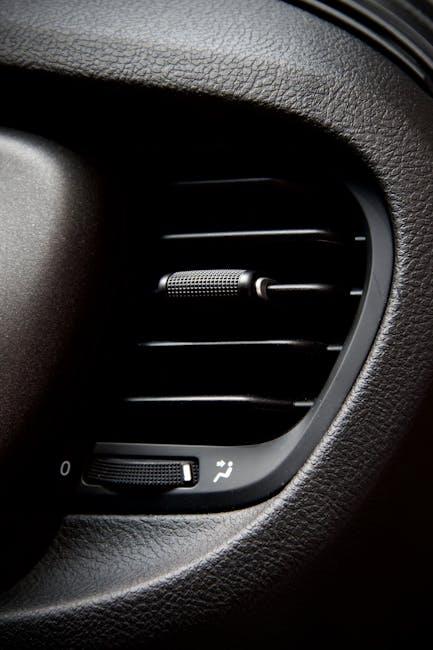When summer’s heat presses in and your car’s air conditioning starts to falter, what was once a refreshing breeze can quickly turn into a frustrating whimper of cool air. Weak air conditioning isn’t just an inconvenience—it can signal underlying issues that affect your comfort and your vehicle’s performance. Understanding how to diagnose the signs of a struggling AC system is the first step toward restoring that crisp, cold airflow you rely on. In this article, we’ll explore practical ways to identify the symptoms of weak car air conditioning, helping you pinpoint the problem before it turns into a costly repair.
Table of Contents
- Understanding the Signs of Weak Air Conditioning in Your Vehicle
- Checking Refrigerant Levels and Identifying Leaks
- Inspecting the AC Compressor and Electrical Components
- Evaluating Airflow Issues and Cabin Filter Condition
- Diagnosing Temperature Control System Malfunctions
- When to Seek Professional Assistance for Accurate AC Diagnosis
- Q&A
- Insights and Conclusions

Understanding the Signs of Weak Air Conditioning in Your Vehicle
When your car’s air conditioning starts to lose its cool touch, it’s often more than just a minor inconvenience—it can signal underlying mechanical issues that require attention. One of the earliest indicators is slow cooling, where the air blows but lacks the chill it once had. This can be accompanied by a strange odor emanating from the vents, often caused by mold or bacteria build-up within the system. Another subtle clue is unusual noises, such as rattling or squealing when the AC kicks in, which might point to problems with the compressor or belt tension. Paying attention to these signs early can save you from costlier repairs down the road.
- Check for leaks: Damp spots under the car or around the AC components usually mean refrigerant is escaping.
- Monitor airflow: Weak or inconsistent airflow suggests issues with the fan or clogged ducts.
- Smell test: Musty or foul air hints at mold or stale buildup inside the system.
| Symptom | Possible Cause | Recommended Action |
|---|---|---|
| Warm air despite AC on | Low refrigerant level | Refrigerant recharge |
| Hissing noise near dashboard | Refrigerant leak | Leak detection and repair |
| Foul smell from vents | Blocked drain or mold | Cleaning of vents and drain |

Checking Refrigerant Levels and Identifying Leaks
One of the most common culprits behind weak air conditioning in cars is low refrigerant levels. To effectively diagnose this, start by checking the refrigerant pressure with a reliable gauge. The ideal pressure varies by vehicle, but if readings fall below the manufacturer’s suggested range, it’s a clear sign that the system isn’t charged properly. Be mindful that topping off refrigerant without finding the cause of loss can lead to more significant issues. Always use the exact type of refrigerant recommended for your vehicle to avoid damage.
Identifying leaks is the next critical step. Refrigerant leaks often occur at connection points and hoses where wear or damage happens over time. Here are common indicators to look for:
- Oily residue around fittings or compressor seals
- Hissing noises indicating escaping gas
- Visibility of bubbles when a soap solution is applied to suspected spots
For a more systematic check, technicians often employ electronic leak detectors or ultraviolet dye. Both methods help pinpoint elusive leaks that simple visual inspection might miss, allowing you to fix small faults before they escalate into costly repairs.

Inspecting the AC Compressor and Electrical Components
Start by focusing on the heart of your car’s climate control system: the AC compressor. This component compresses the refrigerant and circulates it through the system to produce cold air. Listen for any unusual noises like grinding or squealing, which could indicate internal damage or worn bearings. Check the compressor clutch by observing if it engages when you turn the AC on; if it doesn’t, the compressor may not be receiving power or could be faulty. Additionally, inspect for visible signs of oil leaks around the compressor, as leaks often point to seal failures that reduce cooling efficiency.
Electrical components play a crucial role in keeping the AC system functional. Begin by testing the fuse and relay associated with the AC circuit, which can often blow or fail without obvious symptoms. Use a multimeter to check the continuity of wiring harnesses and connectors leading to the compressor and other essential parts. Pay close attention to corrosion or loose connections, which can disrupt power flow and cause erratic compressor operation. Regularly verifying these electrical elements ensures your air conditioning system stays responsive and performs at its best.

Evaluating Airflow Issues and Cabin Filter Condition
When your car’s air conditioning blows weakly, the first suspect should often be the airflow pathways. A meticulous inspection of air vents and ducts can reveal blockages caused by dust buildup, debris, or even small critters that might have found refuge inside. Ensure each vent opens fully and delivers air uniformly. Sometimes, gently cleaning these vents with a brush or compressed air restores the optimal flow that was hampered over time.
The cabin air filter plays a crucial yet overlooked role in maintaining strong and fresh airflow. A clogged or dirty filter significantly reduces the volume of cool air reaching the cabin, forcing your AC system to work harder. Here’s a quick checklist to assess its condition:
- Visual Inspection: Remove the filter and check for dirt, leaves, or mildew.
- Replacement Interval: Verify when the filter was last changed; most require replacement every 12,000 to 15,000 miles.
- Airflow Test: Notice any change in airflow strength when the filter is removed (briefly and carefully).
| Filter Condition | Effect on Airflow | Recommended Action |
|---|---|---|
| Clean | Strong, consistent airflow | Maintain regular replacement schedule |
| Lightly Dirty | Reduced airflow, slight odor | Replace soon |
| Heavily Clogged | Minimal airflow, musty smell | Immediate replacement required |

Diagnosing Temperature Control System Malfunctions
When your vehicle’s air conditioning is underperforming, pinpointing the root cause often requires a methodical evaluation of the temperature regulation components. Begin by inspecting the thermostat and temperature sensor, as these devices govern the AC system’s responsiveness to climate conditions. Faulty or miscalibrated sensors can send incorrect signals to the climate control module, resulting in inconsistent cooling. Additionally, check the blend door actuator—if it fails to direct airflow properly, cold air may not reach the cabin despite the system operating at full capacity.
To isolate the issue further, you can rely on a structured checklist of symptoms and their potential causes:
- Air is lukewarm: Possible low refrigerant levels or clogged condenser.
- Rapid temperature fluctuations: Faulty thermostat or malfunctioning climate control module.
- Weak airflow: Issues with blower motor or air filter blockage.
| Component | Common Symptom | Suggested Action |
|---|---|---|
| Thermostat | Inconsistent cabin temperature | Test and recalibrate or replace |
| Blend Door Actuator | Airflow misdirection | Inspect and repair motor gears |
| Temperature Sensor | Inaccurate temperature readings | Clean or replace sensor |

When to Seek Professional Assistance for Accurate AC Diagnosis
While it’s tempting to try diagnosing your car’s weak AC issues on your own, certain symptoms clearly warrant professional evaluation. If you notice inconsistent cooling, strange noises from the AC system, or a sudden loss of airflow, these are signs that go beyond simple troubleshooting. Attempting to fix these issues without proper tools can lead to further damage or missed underlying problems such as refrigerant leaks or compressor failure.
Additionally, if you find yourself stuck with any of the following situations, it’s best to seek expert help:
- Repeated refrigerant refills without improvement
- Unusual odors coming through vents
- Visible cracks or corrosion on AC components
- Electrical issues affecting the AC controls or fan
| Symptom | Possible Cause | Recommended Action |
|---|---|---|
| Warm Air | Low Refrigerant | Professional leak detection and recharge |
| Foul Smell | Mold or Debris | Cleaning and filter replacement |
| Weak Airflow | Clogged Vents or Faulty Blower | Inspection and repair by technician |
| AC Compressor Noise | Mechanical Fault | Diagnose and replace compressor if needed |
Q&A
Q: What are some common signs that my car’s air conditioning is weak?
A: If your car’s A/C takes a long time to cool down the cabin, blows air that isn’t cold enough, or only works intermittently, these are clear signs of weak performance. You might also notice strange odors or unusual noises when the A/C is running.
Q: How can I perform a basic check of my car’s air conditioning system?
A: Start by turning on the A/C at full blast with the engine running. Feel the temperature of the air coming from the vents—if it’s only slightly cooler than outside air or barely cool at all, the system may be struggling. Also, listen for any odd sounds like hissing or rattling.
Q: Could a weak AC be caused by low refrigerant levels?
A: Absolutely. Refrigerant is the lifeblood of your car’s cooling system. If it leaks or depletes over time, the AC won’t blow cold air effectively. A refrigerant recharge by a professional can often restore cooling performance.
Q: How do I know if there’s a refrigerant leak?
A: Clues include oily residue around A/C hoses or connections, the hissing sound of escaping gas, and reduced cooling performance over time. A mechanic can use special dyes or electronic detectors to pinpoint the leak.
Q: Can a clogged cabin air filter affect AC performance?
A: Yes. A dirty or blocked cabin air filter restricts airflow, making the air conditioning seem weaker. Replacing it regularly helps maintain fresh, cool air inside your car.
Q: What role does the compressor play in diagnosing weak AC?
A: The compressor pumps refrigerant through the system. If it’s failing or not engaging properly, the AC won’t cool well. Signs of compressor trouble include strange noises, frequent cycling on and off, or no cold air despite the fan working.
Q: Are electrical issues a common culprit in weak AC systems?
A: Electrical components like fuses, relays, and switches control the AC system. Faulty wiring or blown fuses can prevent the compressor or fans from operating correctly, weakening cooling.
Q: When should I see a professional to diagnose my car’s weak air conditioning?
A: If basic checks don’t identify the problem, or if you suspect refrigerant leaks, compressor failure, or electrical issues, a certified technician can perform comprehensive diagnostics and repairs safely and effectively.
Q: How can regular maintenance prevent weak AC problems?
A: Routine inspections, timely filter replacements, and addressing minor leaks early help keep the air conditioning system functioning optimally and extend its lifespan. Preventive care is the key to staying cool on the road!
Insights and Conclusions
In the end, a weak air conditioning system is more than just an inconvenience—it’s a signal from your car that something needs attention. By understanding the signs and knowing how to diagnose the issue, you equip yourself with the power to keep your ride cool and comfortable, no matter the heat outside. Whether it’s a simple fix or a call for professional help, staying informed ensures your car’s air conditioning won’t leave you out in the cold—or the sweltering heat—when you need it most. Keep these tips in mind, and drive into every season with confidence and comfort.


3 Comments
btfca3
4ewwri
z70pfl